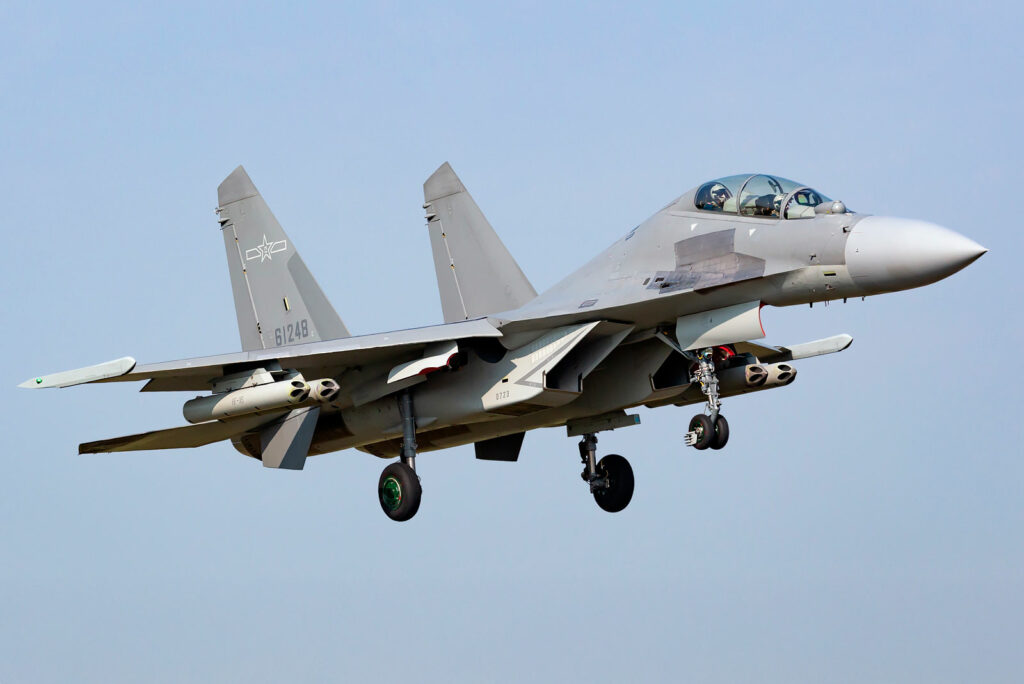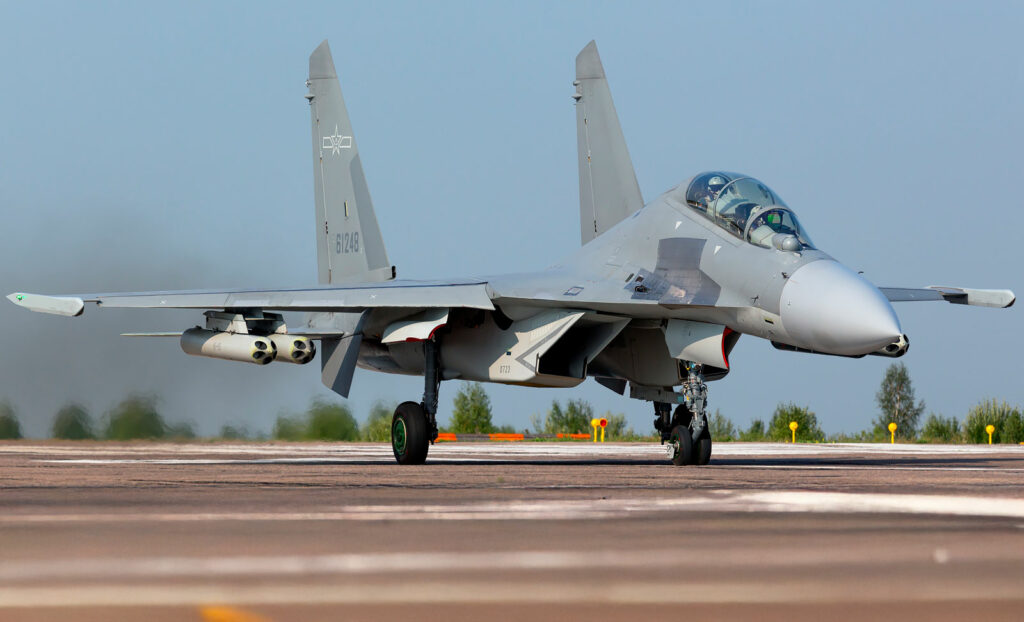Shenyang J-16 (Red Eagle): A multi-role fighter designed for air superiority and ground attack, equipped with advanced radar, sensors, and high payload.
In brief
The Shenyang J-16 Red Eagle is a multi-role fighter developed by the Shenyang Aircraft Corporation under AVIC (Aviation Industry Corporation of China). Designed as an enhanced variant of the Su-30MKK, it incorporates Chinese avionics, radar systems, and electronic warfare capabilities. The J-16 is optimized for air-to-air combat, ground attack, and electronic warfare. With twin WS-10A engines, it has a maximum speed of Mach 2.2 and a range of up to 3,000 kilometers (1,864 miles). The J-16 carries a versatile weapons payload, including air-to-air, air-to-surface, and anti-ship missiles, with a maximum load of 12,000 kilograms (26,455 pounds). Its advanced AESA radar and electronic warfare systems enhance its combat effectiveness in complex, high-threat environments, making it a significant asset for the People’s Liberation Army Air Force (PLAAF).
The Shenyang (AVIC) J-16 (Red Eagle)
The Shenyang J-16, also known as the Red Eagle, is a multi-role fighter developed by the Shenyang Aircraft Corporation (AVIC) for the People’s Liberation Army Air Force (PLAAF). It is designed to operate in both air-to-air and air-to-ground combat, with the flexibility to conduct various missions in contested environments. Based on the Russian Su-30MKK, the J-16 incorporates advanced Chinese-made avionics, radar, and weapon systems, representing a shift towards indigenously developed combat capabilities. With enhanced electronic warfare and surveillance capabilities, the J-16 provides the PLAAF with a versatile, high-performance fighter for modern air combat scenarios.

History of the Development of the Shenyang (AVIC) J-16 (Red Eagle)
The J-16 program began as part of China’s effort to enhance its air force’s multi-role combat capabilities. During the 1990s, the People’s Liberation Army Air Force (PLAAF) recognized the need for advanced multi-role fighters that could meet the demands of a modernized air force. China had acquired the Su-30MKK from Russia, which was a formidable multi-role fighter, yet reliance on foreign technology presented limitations. In response, China’s defense industry began working to develop a domestic platform that would integrate Chinese technologies, reducing dependency on imported systems and creating a more capable and versatile fighter.
Shenyang Aircraft Corporation, a major division of AVIC, undertook the task of creating a modern fighter that could serve as an improved successor to the Su-30MKK. The goal was to develop an aircraft capable of performing air superiority, ground attack, and electronic warfare missions, with enhanced endurance and survivability. Shenyang’s experience with the Su-27 and Su-30 platforms provided a solid foundation for this project. Engineers sought to retain the robust airframe of the Su-30MKK while incorporating advanced indigenous systems, especially in avionics, radar, and weaponry.
Development officially commenced in the early 2000s. The primary objective was to create an aircraft that could rival Western multi-role fighters while maintaining operational efficiency and compatibility with China’s existing military infrastructure. The PLAAF required a fighter that could undertake diverse missions, including engaging enemy aircraft, conducting precision strikes on ground targets, and performing in high-threat environments where electronic warfare would be essential.
The J-16 first flew in October 2011, marking a significant milestone in China’s military aviation advancements. The airframe design retained the twin-seat layout of the Su-30MKK, but engineers installed Chinese-developed engines, radar, and avionics. The Active Electronically Scanned Array (AESA) radar system on the J-16 improved its target detection, tracking range, and ability to engage multiple targets simultaneously, enhancing its effectiveness in both air-to-air and air-to-ground combat.
By 2013, the J-16 had completed testing and entered service with the PLAAF, fulfilling its role as a multi-role, high-performance fighter. Over the years, the J-16 has been integrated into the PLAAF’s strategic plans, performing in joint exercises and regional patrols. Its capabilities have strengthened China’s air power, allowing it to assert greater control over key areas, including the East and South China Seas.
Today, the J-16 serves as a core component of China’s multi-role fighter fleet. With advancements in radar, electronic warfare, and stealth capabilities, the J-16 continues to be modernized, ensuring its relevance in future combat scenarios. The J-16’s development demonstrates China’s growing competence in producing advanced fighter aircraft, contributing to the PLAAF’s strategic goals in Asia.
Design of the Shenyang (AVIC) J-16 (Red Eagle)
The design of the Shenyang J-16 incorporates features from the Su-30MKK while integrating significant Chinese advancements in avionics, materials, and combat systems. The J-16 is built to operate effectively in multi-role combat scenarios, from air-to-air engagements to ground attack missions.
Airframe and Structure: The J-16 has a length of 22 meters (72.2 feet), a wingspan of 15 meters (49.2 feet), and a height of 6 meters (19.7 feet). The aircraft’s twin-tail, twin-engine configuration enhances stability and maneuverability, allowing it to operate effectively at high speeds and in complex aerial environments. The J-16’s airframe is reinforced to withstand the stress of heavy payloads, and composite materials are used to reduce weight and improve durability.
Cockpit and Avionics: The J-16 features a two-seat cockpit, enabling a pilot and weapons systems officer (WSO) to operate the aircraft’s advanced avionics and weapons systems. The cockpit is equipped with modern glass displays, digital control systems, and advanced sensor integration, enhancing situational awareness and reducing pilot workload. The avionics suite includes a sophisticated AESA radar, providing long-range detection and tracking, as well as high-resolution imaging for targeting ground objectives.
Engines: Powered by two WS-10A Taihang engines, each producing around 29,000 pounds (130 kN) of thrust, the J-16 achieves speeds of up to Mach 2.2. These engines enable the J-16 to perform high-speed interceptions and sustained supersonic flight, critical for air superiority missions. The engines also provide sufficient power to carry a large payload, supporting the aircraft’s multi-role capability.
Weapon Systems: The J-16 is equipped with 12 hardpoints, allowing it to carry a mix of air-to-air missiles, air-to-ground munitions, and anti-ship weapons. The aircraft’s maximum payload capacity is 12,000 kilograms (26,455 pounds), enabling it to conduct a wide range of missions with significant firepower. Standard armaments include the PL-10 short-range air-to-air missile, PL-15 long-range air-to-air missile, and various guided bombs for ground attack.
Stealth and Electronic Warfare: Although not a stealth aircraft, the J-16 incorporates some radar-absorbing materials to reduce its radar cross-section. It is also fitted with electronic warfare systems and countermeasure pods, which enhance survivability in high-threat environments by disrupting enemy radar and missile systems.
Advantages and Drawbacks: The J-16’s design provides versatility, allowing it to perform both air superiority and strike missions. However, its size and weight may limit its agility compared to lighter, single-engine fighters. Future upgrades to the J-16 are expected to improve avionics and materials to enhance its performance further.
Performance of the Shenyang (AVIC) J-16 (Red Eagle)
The Shenyang J-16’s performance characteristics make it a formidable multi-role fighter, equipped for both air-to-air combat and precision ground attacks. Its powerful engines, advanced radar, and weapon systems enable it to perform diverse missions effectively.
Speed and Thrust: The twin WS-10A engines allow the J-16 to reach a maximum speed of Mach 2.2 (1,482 knots, 2,755 km/h). Each engine provides 29,000 pounds (130 kN) of thrust, enabling rapid acceleration and sustained high-speed flight. This speed is advantageous for air superiority missions, allowing the J-16 to intercept and engage enemy aircraft quickly.
Range and Endurance: The J-16 has an operational range of up to 3,000 kilometers (1,864 miles) with internal fuel, which extends with external tanks. This range supports long-duration missions, including patrols and strike operations. The J-16’s endurance is critical for power projection and allows it to operate over extensive distances without refueling.
Altitude Capabilities: The J-16 operates effectively at high altitudes, with a maximum operational ceiling of 20,000 meters (65,617 feet). High-altitude capabilities enhance its ability to conduct reconnaissance, strike, and interception missions, providing a tactical advantage in situational awareness and engagement range.
Maneuverability: Despite its size, the J-16 maintains good maneuverability, supported by its twin-engine configuration and aerodynamic design. Its canard wings improve lift and control, enabling tight turns and agile maneuvers essential for close combat. However, its larger frame limits
agility compared to lighter, single-engine fighters, which are typically more agile.
Payload and Armament: The J-16 can carry a maximum payload of 12,000 kilograms (26,455 pounds), spread across 12 hardpoints. This payload includes a variety of weapons, from air-to-air missiles such as the PL-10 and PL-15 to air-to-ground munitions like laser-guided bombs and anti-ship missiles. This versatile payload capacity allows the J-16 to adapt its armament to mission-specific requirements, enhancing its operational flexibility.
Comparison to Competitors: Compared to Western fighters like the F-15E Strike Eagle, the J-16 offers similar payload and multi-role capabilities. However, the J-16 benefits from China’s AESA radar and electronic warfare advancements, making it effective in high-threat environments. While it may lack some stealth capabilities, its radar and countermeasures ensure survivability in contested airspace.

Variants of the Shenyang (AVIC) J-16 (Red Eagle)
The J-16 platform has been developed in multiple variants, each adapted for specific roles to enhance the PLAAF’s combat capabilities.
- J-16 Standard Variant: This is the multi-role fighter configuration, equipped for both air-to-air and ground attack missions. It includes the AESA radar, electronic warfare systems, and a comprehensive suite of weapons.
- J-16D: The J-16D is an electronic warfare variant designed for suppression of enemy air defenses (SEAD). It carries specialized jamming pods, electronic countermeasures, and additional sensors for electronic warfare. This version is essential for creating air superiority in heavily defended areas.
- J-16A: The J-16A is an upgraded variant with improved avionics and electronic systems. This version benefits from advances in radar, weapon control, and navigation, enhancing its multi-role efficiency.
Military Use and Combat of the Shenyang (AVIC) J-16 (Red Eagle)
The J-16 is a core element in the PLAAF’s tactical fleet, offering robust air-to-air and air-to-ground capabilities that support China’s defense and power projection goals. It has been deployed in various exercises and regional patrols, solidifying its role as a multi-role fighter.
Armament and Versatility: The J-16’s diverse payload options allow it to carry air-to-air missiles, anti-ship missiles, and precision-guided bombs. Equipped with PL-10 and PL-15 air-to-air missiles, the J-16 excels in air superiority roles, capable of engaging multiple targets with high accuracy. Additionally, the YJ-83 anti-ship missile enhances its capability to strike maritime targets, providing a valuable asset for securing coastal areas.
Operational Deployment: The J-16 has been deployed across various Chinese airbases, often participating in training exercises and regional operations near Taiwan and the South China Sea. These deployments serve as a demonstration of China’s military presence and reinforce the PLAAF’s readiness to respond to regional threats.
Electronic Warfare Role: The J-16D variant has expanded the J-16’s role in electronic warfare, focusing on disrupting and suppressing enemy air defenses. In SEAD missions, the J-16D disrupts enemy radar and communication systems, creating an advantage for friendly forces. This electronic warfare capability is vital for modern combat scenarios where air superiority is often contested.
Comparisons and Competitors: The J-16 faces competition from Western fighters such as the F-15E Strike Eagle and the Su-35. While the F-15E emphasizes advanced avionics and weapon systems, the J-16’s electronic warfare capabilities offer a competitive advantage in high-threat environments. Compared to the Su-35, the J-16 benefits from Chinese-made avionics and radar, designed to integrate seamlessly with PLAAF operational protocols.
Current Status and Future Prospects: The J-16 remains actively deployed within the PLAAF, with upgrades anticipated to further improve its avionics, radar, and weapons systems. As China advances its air defense technology, the J-16 is expected to remain relevant, serving as a cornerstone of China’s tactical air operations.
Back to the Fighter Jet section.